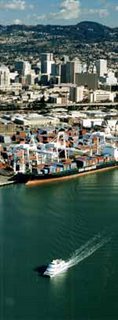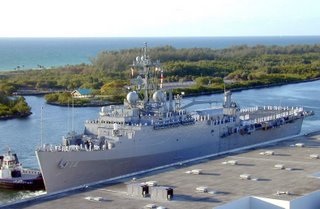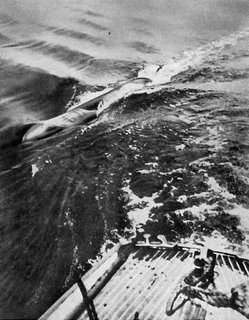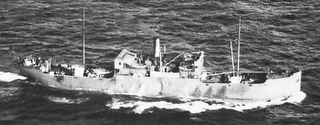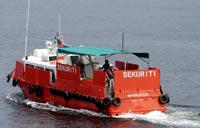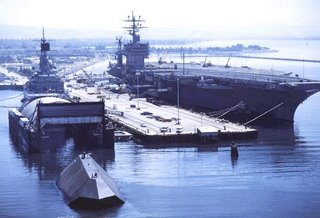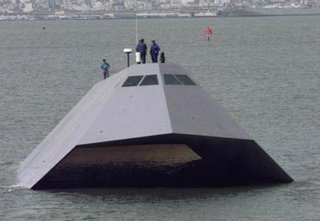
After the various declarations of war that followed Pearl Harbor, the Germans began a devastating U-Boat campaign off the U.S. East Coast. On the West Coast, the Japanese also conducted some attacks, but, as will be seen, they were in no way close to being severe. On the other hand, one remarkable submarine, the
I-25, was involved in a series of attacks that included launching an aircraft to drop fire bombs into the Oregon forests, shelling U.S. forts and attacking shipping in the Pacific. Most of the story is set out
here, but here are a few highlights of the
I-25's wartime
career:
The I-25 was one of eleven Japanese submarines configured to carry a seaplane. The aircraft provided a unique reconnaissance capability, but could also carry two bombs. Although the plane-equipped submarines were primarily intended for reconnaissance and scouting missions, they were heavily armed and capable of surface and submerged attack.
***
The I-25 displaced 2,584 tons submerged, with a length of 356 feet. Its twin diesel engines and two propeller shafts were capable of providing a cruising range of over 14,000 miles. The submarine carried a crew of 97 men, including a pilot and crewman for the seaplane.
Armament included 17 torpedoes and a 5.5 inch deck gun, as well as two 25mm antiaircraft guns.

The seaplane was housed in a watertight hangar forward of the conning tower. The wings and floats were removed and the horizontal stabilizer folded up to fit in the hangar. Two launch rails extended from the hangar to the bow. A compressed-air catapult launched the reassembled plane. For recovery, the pilot landed on the surface, taxied to the submarine and was hoisted aboard.
During Pearl Harbor, the
I-25 was standing by to launch her aircraft for battle damage assessment, however, her aircraft was damaged while transiting across the Pacific, and she was unable to fulfill her mission:
7 December 1941: Operation "Z" - The Attack on Pearl Harbor:
The I-25 patrols a line 120 miles NE of Pearl Harbor with the I-9, -15 and -17 during the attack. One of the primary tasks assigned to the I-25 is post-attack aerial reconnaissance; however, her Yokosuka E14Y1 "Glen" floatplane is damaged in transit making such a flight impossible.(Source)
She does attempt to chase the U.S. carrier
Yorktown, but comes under air attack from planes from
USS Enterprise and eventually is ordered to patrol off the U.S. West Coast near the Columbia River. On 27 December 1941,
I-25 attacks an oil tanker,
Connecticut, which, while hit, does not sink, but grounds itself off the Oregon coast. After patrols off Australia and New Zealand and various refittings,
I-25 is sent to recon Dutch Harbor, Alaska as part of the pre-Midway feint desinged to split US forces. In June, 1942, she arrives again off the Oregon coast where she engages in activities designed to confuse and harass the Americans, including launching small floating fake periscopes, attacking shipping and, in a remarkable show of courage, shells Fort Stevens, one of the forts guarding the entrance to the Columbia River. See
here:
On June 21, 1942, the Imperial Japanese Navy submarine I-25 shells the U.S. Army's Fort Stevens coastal defenses on the Oregon side of the mouth of the Columbia River. The Japanese are retaliating for the U.S. bombing of Japan the prior April. The U.S. batteries do not return fire and there is no serious damage. The attack is the first enemy shelling of a U.S. mainland military installation since the War of 1812.
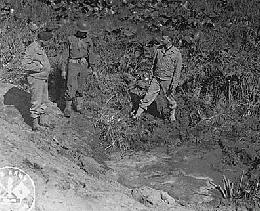
(Photo caption:Soldiers and Japanese shell crater, Fort Stevens, Oregon, June 1942
Courtesy National Archives, (ARC 299678)
The mouth of the Columbia River was defended by three Army forts: Fort Stevens on the Oregon side and Forts Canby and Columbia on the Washington side. In 1942, Coast Artillery and National Guard units manned heavy guns and mortars dating from the turn of the twentieth century. The weapons covering the beaches dated from World War I.
***
On the evening of June 21, 1942, the I-25 used a screen of fishing boats to avoid minefields off the Columbia and took position off Fort Stevens. On the surface, the crew fired its 14 cm (5.5 inch) deck gun at the shore without taking aim. At the first shot, soldiers at the fort manned their guns and searchlights, and lookouts could see the sub firing. But the enemy ship was plotted (erroneously) to be out of the range, and the artillerymen never received permission to return fire. Also, the fort's commander did not want to give away the precise location of the defenses.
The I-25's shells fell harmlessly in the sand and scrub around Battery Russell, damaging only the baseball diamond backstop and a power line. One soldier cut his head rushing to his battle station. At about midnight, firing ceased and the sub departed to the west, then north.
The shelling of Oregon would be a remarkable feat on its own, but
I-25 came back for more:
In the summer of 1942, the Japanese high command developed a plan to attack the dense forest in the Pacific Northwest. The Japanese hoped that a large forest fire would draw American attention to defense of the west coast and cause the U.S. Navy to reposition its Pacific fleet closer to the mainland. The I-25 was ordered to undertake this operation, and was provided with six incendiary bombs for the mission.
So began a very successful patrol for the I-25. The submarine departed Yokosuka on August 15, 1942, and arrived off the Port Orford Heads on the Oregon coast by early September in bad weather. By September 9, weather conditions had improved. The I-25 surfaced just before dawn and the Glen seaplane was assembled and readied for the attack. Fujita took off at sunrise and flew northeast toward the easily visible Cape Blanco lighthouse. After flying southeast for about 50 miles, Fujita dropped one of his two incendiary bombs on Mount Emily, releasing the second a few minutes later a several miles east of the first. The bad weather that had delayed his mission a few days earlier had saturated the woods, and rendered the bombs ineffective. Otherwise, the bombs could have started large forest fires.
After releasing the bombs, Fujita descended to low level and returned to the waiting submarine. A U.S. Army A-29 bomber aircraft on patrol from McChord Field in Tacoma spotted the submarine, now on the surface to recover Fujita’s aircraft. The A-29 attacked the submarine with several bombs, but only inflicted minor damage as the submarine dove to the relative safety of the ocean floor just west of Port Orford.
The captain of the I-25 mounted a second attempt to ignite a large fire in the Oregon forests. The submarine surfaced just after midnight on Tuesday, September 29, about 50 miles west of Cape Blanco. Although the entire west coast of Oregon was blacked out, the Cape Blanco lighthouse was still in operation. Using the light as a navigation beacon, Fujita flew east over the coast for about 90 minutes and dropped his bombs. Although Japanese Navy records indicate that Fujita observed flames on the ground after this attack, no traces of the attacks have ever been located. The only U.S. records of this attack were of an unidentified aircraft flying east of Port Orford.
The I-25 did not use its last two incendiary bombs, and reverted to torpedo attacks on American shipping. On Sunday, October 4, the submarine sank the freighter SS Camden off Coos Bay on the south Oregon coast; one crewman was killed. The following Tuesday, the I-25 was successful again, this time sinking the tanker SS Larry Doheny off Cape Sebastian. Two crewmen and four U.S. Navy Armed Guards manning guns on the Doheny were killed in the attack.
As noted in its history, the
I-25 is also suspected of sinking "USS
Grunion (SS-216) near Kiska in the Aleutian Islands" and "the Soviet submarine L-16 while the Russians were in transit from Dutch Harbor, Alaska, to San Francisco."
I-25 continued her missions until her luck ran out:
On September 3, 1943, the U.S. Navy destroyers USS Ellet (DD-398) and USS Patterson (DD-392) sank the I-25 approximately 150 miles northeast of Espiritu Santo.
A remarkable ship and crew.
Thought you might like to know.





